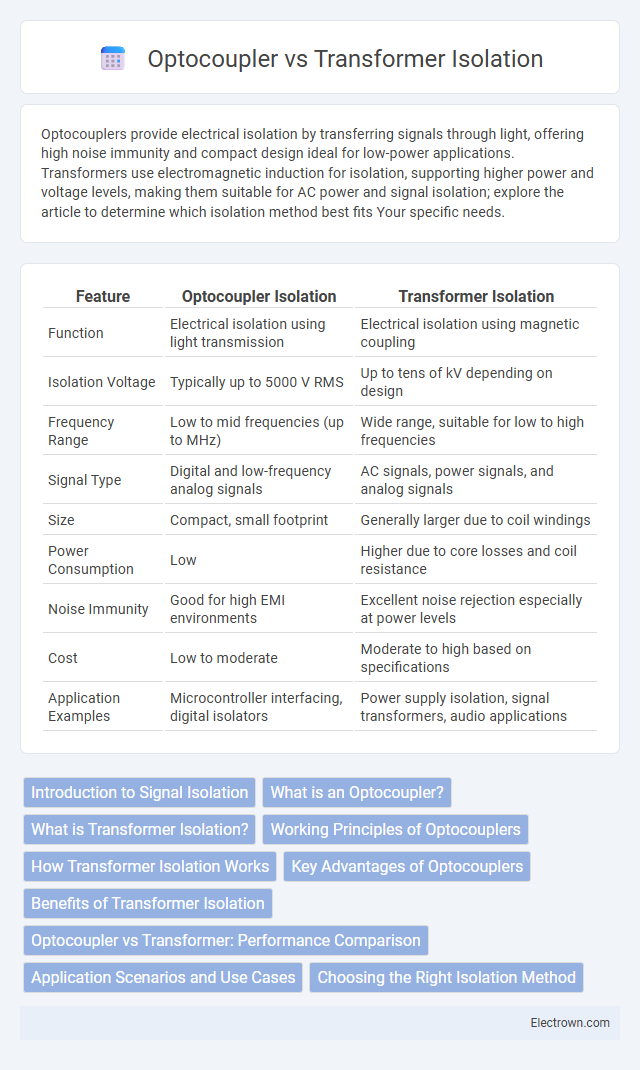Optocouplers provide electrical isolation by transferring signals through light, offering high noise immunity and compact design ideal for low-power applications. Transformers use electromagnetic induction for isolation, supporting higher power and voltage levels, making them suitable for AC power and signal isolation; explore the article to determine which isolation method best fits Your specific needs.
Table of Comparison
| Feature | Optocoupler Isolation | Transformer Isolation |
|---|---|---|
| Function | Electrical isolation using light transmission | Electrical isolation using magnetic coupling |
| Isolation Voltage | Typically up to 5000 V RMS | Up to tens of kV depending on design |
| Frequency Range | Low to mid frequencies (up to MHz) | Wide range, suitable for low to high frequencies |
| Signal Type | Digital and low-frequency analog signals | AC signals, power signals, and analog signals |
| Size | Compact, small footprint | Generally larger due to coil windings |
| Power Consumption | Low | Higher due to core losses and coil resistance |
| Noise Immunity | Good for high EMI environments | Excellent noise rejection especially at power levels |
| Cost | Low to moderate | Moderate to high based on specifications |
| Application Examples | Microcontroller interfacing, digital isolators | Power supply isolation, signal transformers, audio applications |
Introduction to Signal Isolation
Signal isolation is crucial for protecting sensitive circuits from voltage spikes and noise, ensuring accurate data transmission between different system components. Optocouplers provide electrical isolation by using light to transfer signals across an insulating barrier, offering compact size and low power consumption. Transformers achieve isolation through magnetic coupling, delivering high voltage isolation and signal integrity for AC signals in power applications, with each method suited to different frequency and signal type requirements.
What is an Optocoupler?
An optocoupler is a semiconductor device that transfers electrical signals between two isolated circuits using light, providing electrical isolation and noise immunity. It consists of an LED that emits infrared light and a photodetector, such as a phototransistor or photodiode, which detects the light and converts it back to an electrical signal. Your choice of an optocoupler ensures high-speed signal transmission with minimal electromagnetic interference compared to transformer isolation.
What is Transformer Isolation?
Transformer isolation uses electromagnetic coupling between primary and secondary windings to transfer electrical signals while providing galvanic isolation and voltage level shifting. It effectively blocks DC currents and allows AC or pulsed signals to pass, ensuring safety and noise reduction in power supplies and signal transmission. Unlike optocouplers, transformers are well-suited for high-frequency applications and can handle higher power levels without degradation.
Working Principles of Optocouplers
Optocouplers provide electrical isolation by transmitting signals through light within a sealed package, where an LED converts an electrical input signal into light that a phototransistor or photodiode detects on the output side. This method prevents direct electrical connection, enhancing noise immunity and protecting sensitive components from voltage spikes. The isolation barrier in optocouplers typically withstands thousands of volts, making them ideal for signal isolation in various electronic applications.
How Transformer Isolation Works
Transformer isolation operates by transferring electrical energy between two isolated circuits through magnetic coupling within a core, which allows signal transmission without direct electrical contact. This method provides galvanic isolation, effectively blocking DC components while allowing AC signals to pass, making it ideal for power supplies and signal isolation in noisy environments. The transformer's windings create magnetic fields that induce voltage in the secondary coil, ensuring safe separation and noise immunity between the input and output circuits.
Key Advantages of Optocouplers
Optocouplers provide superior electrical isolation by using light to transmit signals between circuits, eliminating direct electrical connections and significantly reducing noise interference and signal distortion. They are compact, cost-effective, and offer fast response times suitable for high-speed switching applications, making them ideal for protecting sensitive components in your designs. Unlike transformers, optocouplers do not require magnetic materials, which enhances reliability and enables operation across a wide frequency range.
Benefits of Transformer Isolation
Transformer isolation provides galvanic isolation that effectively blocks high voltage surges and noise, ensuring enhanced safety in electrical systems. It supports wide frequency ranges and handles high power transfer, making it ideal for power supply applications. Transformers also offer robust durability and thermal stability, contributing to long-lasting performance in harsh environments.
Optocoupler vs Transformer: Performance Comparison
Optocouplers offer superior signal isolation up to 10 kV, minimal electromagnetic interference, and faster response times compared to transformers, which typically provide isolation up to 2-5 kV with inherent inductive delays. Transformers excel in power handling and efficient voltage conversion, supporting higher frequencies in the kHz range, whereas optocouplers are optimized for low-power signal transmission with bandwidths typically limited to a few MHz. In performance-critical applications, optocouplers are preferred for precise digital signal isolation, while transformers are better suited for power transfer and AC signal isolation tasks.
Application Scenarios and Use Cases
Optocouplers provide low-power, high-speed signal isolation ideal for microcontroller interfaces, data communication, and low-voltage control circuits, ensuring noise immunity and signal integrity. Transformers excel in power isolation and voltage level shifting for AC power supplies, audio devices, and industrial machinery, supporting high-voltage and high-current applications. Selection depends on specific requirements such as signal type, power levels, frequency response, and size constraints in medical equipment, renewable energy systems, and consumer electronics.
Choosing the Right Isolation Method
Choosing the right isolation method depends on your application's voltage requirements, signal frequency, and size constraints. Optocouplers provide compact, low-voltage isolation ideal for signal-level communication, while transformers offer robust power isolation and handle high-frequency signals efficiently. Evaluating factors such as isolation voltage rating, signal integrity, and electromagnetic interference susceptibility helps determine whether an optocoupler or transformer best suits your design needs.
Optocoupler vs Transformer Isolation Infographic

 electrown.com
electrown.com